
So far you have learned about the physiology behind weight training and the equipment you will use. Now is an ideal time to master the fundamental lifting skills that you will use in every workout. The lifting techniques described in this step can be applied to everyday physical tasks at home and work, thus decreasing the likelihood of injury to your low back. You will also learn how to warm up and cool down appropriately, how to breathe correctly while weight training, and how to use and be a spotter for free-weight exercises.
Correctly performing basic lifting skills avoids placing excessive stress on muscles, tendons, ligaments, bones, and joints. One of the most common debilitating conditions is low back pain, a condition that affects at least 80 percent of adults at some point in their lives. Americans spend at least $50 billion each year on care of low back pain and miss an average of more than seven days of work a year. The total economic cost in the United States when health care, loss-of-work time, and reduced productivity are considered has been estimated to be over $200 billion each year. In addition to preventing injury, proper lifting skills produce quicker training results because muscles can be properly stressed and stimulated more effectively. Effective training sessions should start and end with warm-up and cool-down exercises that are explained in this step.
The fundamentals learned in this step can be applied to all exercises and spotting procedures described in this text. When you are learning and practicing basic lifting and spotting skills, consider using a dowel stick (like a broom handle), a very light bar, the lightest weight plate on a machine, or only your body weight.
Because of the demands that training places on muscles and joints, warming up and cooling down properly before and after each training session is important. Warm-up activities such as brisk walking or jogging in place for about five minutes followed by an appropriate stretching routine help to increase blood and muscle temperature, thereby enabling muscles to contract and relax with greater ease. Stretching also improves flexibility (the ability to move joints through a full range of motion) and helps prevent injury.
Go through a warm-up activity and then follow the series of static stretching exercises described and shown in this step. Be sure to move slowly into the stretched positions; do not bounce. The stretches presented involve major joints and muscle groups, especially the less flexible muscles of the backs of the legs, the upper and low back, and the neck.
Also perform these stretching exercises immediately after each training session to help speed recovery from muscle soreness. Hold each of the stretching positions for at least 10 seconds and repeat two or three times.
Grasp your hands together behind your back and slowly lift them upward (figure 2.1), or simply reach back as far as possible if you are not able to grasp your hands. For an additional stretch, bend at the waist and raise your arms higher.

With your left hand, grasp your right elbow and pull it slowly across your chest toward your left shoulder. You will feel tension along the outside of your right shoulder and arm (figure 2.2). Repeat with the other arm. You can vary this stretch by pulling the arm across and down over your chest and upper abdomen.

Bring both arms overhead and hold your right elbow with your left hand. Allow your right arm to bend at the elbow, and let your right hand rest against the back of your upper back. Slowly pull with your left hand to move your right elbow behind your head until you feel a stretch (figure 2.3). Repeat with the other arm.

Sit with your left leg straight. Bend your right leg and cross your right foot over your left leg, placing it next to the outside of your left knee with the sole of your foot flat on the floor. Then twist your body to the right and use your left elbow to push against the outside of your upper right thigh, just above the knee. Next, place your right hand on the floor behind you, slowly turn your head to look over your right shoulder, and rotate your upper body toward your right hand and arm (figure 2.4). You should feel tension in your low back and your right hip and buttocks. Repeat with the other leg.

While seated on the floor, straighten your left leg. Bend your right leg and place the sole of your right foot so that it is slightly touching the inside of your left knee. Slowly bend forward at the hips and reach toward your left ankle until you feel tension in the back of your left thigh (figure 2.5). Be sure to keep the toes of your left foot pointing up, with your ankle and toes relaxed. Perform the same stretch with the right leg.
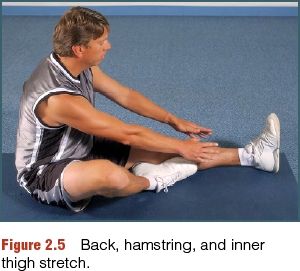
This stretch is performed in the standing position. Using a wall or stationary object for balance, grasp your right foot with your right hand and pull so that your heel moves back toward your buttocks (figure 2.6). You should feel tension along the front of your right thigh. Repeat with your left leg and left hand.

Stand facing a wall about two feet (0.6 m) away. Place your left foot halfway between your right foot and the wall with your left knee slightly flexed. With the heel of your right foot flat on the floor and your right knee straight, lean forward and place your hands on the wall. Apply a stretch on your right calf by slowly moving your hips toward the wall. Be sure to keep your right heel on the floor and your back straight (figure 2.7). Perform the same stretch with the left leg. You can stretch another muscle area of the calf by allowing your right knee to flex slightly while in this same position.

Warm-Up and Cool-Down Drill. Review
Before performing any of the exercises in steps 4 through 10, take time to review and practice the warm-up and cool-down exercises described here. Start with a brisk walk or jog in place for five minutes, then perform the appropriate stretching exercises for the major joints and muscle groups: the chest and shoulders; upper back, shoulder, and arm; shoulder and triceps; back and hip; back, hamstring, and inner thigh; quadriceps; and calves.
Hold each stretch for at least 10 seconds and repeat two to three times. Avoid bouncing! Once you start training, remember to repeat two to three sets of each stretch after your workout as well. For additional information on stretching, consider reading the book, Facilitated Stretching by McAtee and Charland (2007).
Success Check
Always warm up before stretching and after training.
Move slowly into the stretches.
Use static (not ballistic) stretches.
Now with your warm-up completed, you are ready to learn proper lifting techniques that focus on
1. acquiring a good grip,
2. having a stable position from which to lift,
3. keeping the object being lifted close to your body, and
4. using your legs, not your back, when lifting a weight or bar off the floor.
Two things to consider when establishing a grip are the type of grip used and the positioning of the hands on the bar (where on the bar and how far apart they are from each other). The grips that may be used to lift a bar off the floor are the overhand, or pronated, grip; the underhand, or supinated, grip; and the alternated grip. The palms are facing down or facing away from you in the overhand grip (figure 2.8a). In the underhand grip (figure 2.8b), the palms are facing upward or toward you with the thumbs pointing away from each other. The alternated grip (figure 2.8c), sometimes referred to as a mixed grip, involves having one hand in an underhand grip and the other in an overhand grip. In the alternated grip, the thumbs point in the same direction. (It does not matter which hand is positioned overhand or underhand in the alternated grip.) All of these are called closed grips, meaning that the fingers and thumbs are wrapped (closed) around the bar.

An open grip (figure 2.9), sometimes referred to as a false grip, is one in which the thumbs do not wrap around the bar. This grip type is very dangerous because the bar can easily roll out of your hands onto your head, face, or foot, causing severe injury. Always use a closed grip!

Figure 2.10 shows several grip widths used in weight training. In some exercises, the width of the grip places the hands approximately at shoulder-width and equidistant from the weight plates. This is referred to as the common grip.

Some exercises require a narrow grip and others use a wider grip. Learn the proper width for each exercise, as well as where to place the hands, so that the bar is held in a balanced position. Improperly gripped bars with weight plates that are not locked can result in the weights falling or being catapulted off the ends of the bar, causing serious injury. Becoming familiar with the smooth and knurled areas of the bar and where the hands should be placed will help you establish a balanced grip. Note that the common grip is used later in explaining proper lifting techniques.
Several phases must be followed to safely lift a bar off the floor. Some exercises require you to lift the bar from the floor just to the front of your thighs (see figure 2.13, page 20). Other exercises require you to lift the bar from the floor up to your shoulders in two distinct movements (figures 2.13 and 2.14, pages 20 and 22). This approach is typically used to get into the initial or preparatory body position to perform an exercise (for example, see the standing press exercise in step 6, page 70). Some exercises consist entirely of lifting the bar off the floor (see step 10 for descriptions of total-body exercises).
The next section describes the four phases for safely lifting a bar: a beginning or starting phase, two movement phases, and a final phase. The beginning phase has no movement; you just get into the correct initial body position for the exercise. Then, during the final phase, you safely return the bar to the floor.
Take hold of the bar using an overhand grip and position the hands outside of the legs. Now move into the correct preparatory position shown in figure 2.11. Shuffle your feet toward the bar so that your shins are almost touching it. Positioning the bar close to the shins keeps the weight being lifted closer to the body during the lifting/pulling action, enabling you to exert a more effective force with your legs (and avoiding straining your low back). A key concept to remember is that a stable lifting position strategically positions the leg muscles to effectively contribute to lifting the barbell.


Side View
1. Grip slightly wider than shoulder width
2. Feet are shoulder-width apart
3. Feet are flat on floor, toes pointed slightly outward
4. Hips are low—in a “gorilla” position
5. Arms are straight, shoulders are over or slightly forward of bar
6. Head is up and eyes are focused straight ahead throughout exercise
7. Back is flat and tensed
8. Shoulder blades are pulled toward each other
Establish a stable position by placing your feet flat on the floor, shoulder-width apart or slightly wider, with the toes pointing slightly outward. A wide stance, or base of support, provides greater stability and a more balanced lifting position. Establishing a stable position is especially important when performing overhead exercises with dumbbells or a barbell. It is also important when performing machine exercises that require the positioning of the feet on the floor, or the head, torso, hips, and legs on or against equipment.
Think of the body position of a gorilla! Believe it or not, this is an ideal position for lifting a barbell off the floor. To get into this position, grasp the bar as previously described and simultaneously straighten your elbows as you lower your hips. Now position your shoulders over or slightly ahead of the bar while keeping the head up. Focus your eyes straight ahead. Your back should be in a flat or slightly arched position. Establish a chest-out-and-shoulders-back position by pulling the scapulae (shoulder blades) toward each other. Avoid the rounded back position shown in figure 2.12.
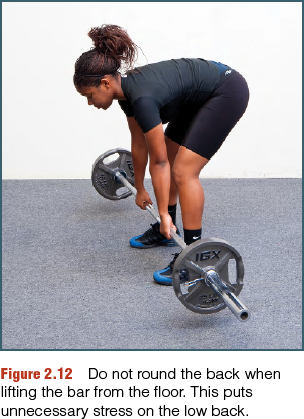
In addition, a proper head position, with the eyes looking straight ahead, is critical to maintaining proper body positioning. If there is a mirror available, watch yourself as you move into the low preparatory position. Does your back stay in a flat position, and do your heels stay in contact with the floor? Often one or both heels will lift up when you move into the low position shown in figure 2.11, causing you to step forward to catch your balance.
Get a mental picture of the head, shoulder, back, and hip positions. The most important things to remember are to keep the barbell, dumbbell, or weight plate as close to you as possible and to use your leg muscles, not your back! In preparation for standing up to pull the bar off the floor, breathe in to stabilize your upper torso.
During the floor-to-thigh phase shown in figure 2.13, pull the bar upward in a slow, controlled manner. Do not jerk the bar off the floor. Once it reaches the mid-thigh level, exhale. At this height, the barbell may be placed in a rack or handed to a partner. Bringing the bar to this height is also the first phase of a movement that takes the bar to a position at the shoulders in preparation for the standing press exercise described in step 6 on page 70.

Figure 2.13 FLOOR-TO-THIGH PHASE

Preparation
1. Inhale before pulling
2. Pull in a slow, controlled manner
3. Keep the back flat
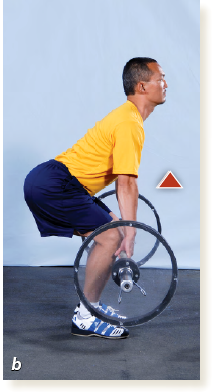
Lift
1. Begin to straighten knees while hips stay low
2. Keep elbows straight
3. Keep bar close to shins, knees, and thighs
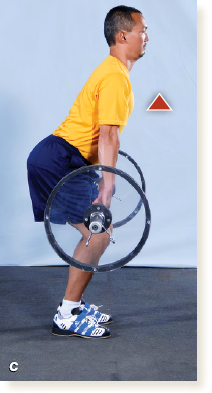
Straighten
1. Keep shoulders over the bar as knees straighten
2. Exhale when bar reaches mid-thigh level
MISSTEP
Your upward pull is not smooth.
CORRECTION
Straighten your elbows before pulling and pull slowly.

MISSTEP
Your hips rise first when pulling.
CORRECTION
This movement puts stress on your back rather than on your legs. Your knees are straightening too soon. Think: I lead my upward movement with my shoulders, not my hips. This will enable you to use your legs instead of your back to do the lifting.

MISSTEP
Your heels lift up or you have too much weight shifted onto the balls of your feet (or both).
CORRECTION
Sit back into the low position and concentrate on evenly distributing the weight onto both feet.
If you need to lift the barbell to your shoulders, continue the upward movement initiated by the previous two phases. Do not allow the bar to slow down or rest on your thighs and do not exhale yet. Instead, continue pulling the bar so that it brushes against your thighs as you pull upward. This keeps the bar close and reduces stress on the low back. As your knees straighten, your hips should move forward quickly.
Follow this movement phase with a rapid shoulder shrug using the trapezius muscles between the neck and shoulders. Exhale immediately after the shrug. At the end of the shrugging motion, flex your elbows and move them upward and out to the sides to continue pulling the bar as high as possible (figure 2.14a).
Once the bar reaches its highest point, rack (catch) the bar on the front of your shoulders by rotating your elbows down under and then up in front of the bar as it touches down on your shoulders and clavicles (figure 2.14b). While catching the bar, flex the knees and hips partially to help absorb the force of the bar’s impact on your shoulders. After reaching a balanced position with your upper arms parallel to the floor, finish the phase by standing up straight.

Figure 2.14 THIGH-TO-SHOULDER PHASE

From Thighs to Highest Bar Position
1. Continue pulling bar upward
2. Bar brushes middle or tops of thighs
3. Keep bar close to body as hips drive forward
4. Keep elbows straight
5. Straighten legs and hips completely then rapidly shrug the shoulders
6. Keep elbows straight and shrug as high as possible
7. Immediately flex elbows and move them upward and sideways
8. Continue pulling bar upward until it reaches its highest point
Catch
1. Immediately rotate elbows down under, then up in front of bar
2. Catch (rack) bar on the front shoulders
3. Flex knees and hips to absorb bar’s impact
4. Move upper arms to be parallel to floor
5. Gain balance and stand up

MISSTEP
The bar stops on your thighs.
CORRECTION
The pull from the floor to your shoulders should be continuous. Do not allow yourself to pause or stop the bar at your thighs.

MISSTEP
The bar swings away from your thighs and hips.
CORRECTION
Concentrate on pulling the bar up straight and keeping it in close to your thighs and hips.

MISSTEP
Your elbows flex too soon.
CORRECTION
Wait until your shrug is at its highest point before flexing your elbows.
When lowering the bar (or any other heavy object) to the floor, use what you have learned about establishing a stable position, keeping the bar close and the back flat, and using your legs instead of your back to lower the bar. Also remember to lower it to the floor in a slow, controlled manner.
With the bar at shoulder height as shown (figure 2.15a), allow its weight to slowly pull your arms to a straightened position (figure 2.15b), which should briefly place the bar in a resting position on your thighs. Your hips and knees should be flexed so that as the bar touches your thighs, its weight is absorbed momentarily before you lower it to the floor. Remember to keep your head up and your back flat throughout the bar’s return to the floor (figure 2.15c).

Figure 2.15 SHOULDER-TO-FLOOR PHASE

Lower
1. Unrack the bar
2. Lower bar to thighs first
3. Flex hips and knees to absorb weight
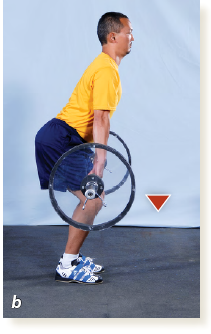
Pause
1. Keep back flat or slightly arched
2. Keep shoulders back
3. Keep bar close to thighs, knees, shins
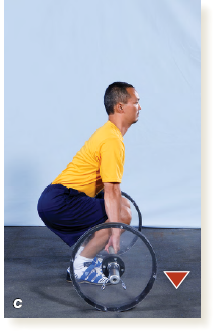
Return
1. Lower bar to floor, under control
MISSTEP
The bar does not pause at your thighs.
CORRECTION
Visualize the downward phase as a two-count movement, “one” to the thighs, “two” to the floor.

MISSTEP
Your hips remain high as you lower the bar from the thighs to the floor.
CORRECTION
This position is stressful on the back! Once the bar reaches the thighs, squat down to lower it while keeping an upright, flat back position.
The best time to exhale in most exercises is during the sticking point, or the most difficult point in a repetition. Inhalation should occur during the relaxation phase or easiest point in a repetition. For example, in the upward movement of the biceps curl, exhalation should occur when the forearms are parallel with the floor (the most difficult point). Inhalation should occur as the bar is being lowered (the easiest point). In exercises in which upper-torso stabilization is needed to help maintain a correct lifting position, such as in the back squat (step 8) or hang clean (step 10), breathing should occur at the end of the sticking point. For most of the exercises and drills shown in steps 4 through 10, remember to breathe out through the sticking point!
Be aware that in most exercises you will have a tendency to hold your breath too long. This should be avoided because it is dangerous! By not exhaling, you reduce the return of blood to your heart, which in turn reduces the blood flow to the brain. If the brain is deprived of oxygen-rich blood, you will become dizzy and may faint. Holding your breath too long is especially dangerous if you are performing overhead free-weight exercises or if you have high blood pressure. Learning to exhale at the correct time can be confusing, but the technique sections in this book will tell you when to exhale for each exercise.
CAUTION: Do not hold your breath. Exhale through the sticking point of an exercise.
A spotter assists and protects the person lifting from injury. Spotters play a crucial role in making weight training a safe activity.
If you are asked to be a spotter, realize that being inattentive can cause serious injuries (muscle or tendon tears, facial and other bone fractures, and broken teeth). Not all exercises require a spotter, but the free-weight bench press and the back squat, and those exercises involving over-the-head or over-the-face movements definitely require one. Specific spotting instructions are provided for the applicable exercises in steps 4 through 9.
Just as you may need to rely on a spotter, the person you spot is relying on you. Do not underestimate the significance of your responsibilities as a spotter. Read and adhere to the following guidelines for spotting free-weight exercises. You should also understand the guidelines about your responsibility to the spotter when you are lifting. Remember: Spotters with poor technique can be injured, too!
1. Remove all loose plates, barbells, and dumbbells from the area to avoid slipping or tripping on them.
2. Learn and practice the spotting techniques and procedures for exercises that involve a spotter.
3. Place your body in a good lifting position in case you have to catch the bar. Keep your knees flexed and your back flat.
4. Effectively communicate with the person you are spotting. For example, before your partner begins a set, ask how many repetitions will be attempted.
5. Use the appropriate grip—a closed grip is a must! Use the proper hand location on the bar if you need to grip it.
6. Check that the bar is properly and evenly loaded.
7. Be knowledgeable about potentially dangerous situations associated with each exercise. These are identified throughout this book.
8. Be alert and quick to respond to the needs of the person you are spotting.
9. Know when and how to guide the bar in the desired path.
10. Know when and how much lifting assistance is needed to complete an exercise.
11. As a last resort, handle all of the weight of the bar, but only if your partner might be injured if you do not take action.
As the person performing a weight training exercise, your actions are important to your spotter’s safety as well as yours. Following these suggestions will help make training safer for both of you.
1. Tell the spotter the number of repetitions you intend to complete before you begin the exercise.
2. Be vocal about when you need assistance.
3. Always stay with the bar. That is, once the spotter needs to assist, remember not to let go of the bar or stop trying to complete the exercise. If you do, the spotter must handle the entire weight of the bar and might be injured.
4. Know your strength and technique limitations and select an appropriate load for each set. (This is a common problem for those who are new to training.)
Lifting Fundamentals Drill 1.
Grip Selection and Location
This drill involves lifting an empty bar or a dowel stick from the floor using the three types of grips in the three grip-width positions described on pages 17-18. When completing this drill, you should position your hands so that the bar is balanced when being pulled to the thighs.
Using the wide grip width (see figure 2.10, page 18) and an overhand grip (see figure 2.8a, page 17), lift the bar to the thighs and then lower it back to the floor using correct lifting techniques. Lift the bar twice more to your thighs, using first the underhand grip (see figure 2.8b, page 17) and then the alternated grip (see figure 2.8c, page 17).
Now move your hands to the common grip width, and use the three different types of grips. Next move your hands to the narrow grip, and do the same. Perform all grips with your thumbs around the bar. Check off each correctly performed grip and grip width.
Success Check
Establish the proper hand spacing.
Keep your thumbs around the bar.
Remember the names of the grips.
Score Your Success
Complete three overhand grips with correct technique = 3 points
Complete three underhand grips with correct technique = 3 points
Complete three alternated grips with correct technique = 3 points
Your score ___
Lifting Fundamentals Drill 2.
Preparation Position
This drill will help you develop a better sense of balance and a greater awareness of proper body positioning.
Without falling forward or allowing either or both heels to rise, squat down into the gorilla position with your hands clasped behind your head. Move into this position 10 times. Performing this drill in front of a mirror is a great way to critique and perfect your technique.
Success Check
Keep heels on floor and back flat.
Keep head upright.
Keep eyes focused straight ahead.
Score Your Success
Give yourself 1 point for each repetition performed with good balance, for a maximum total of 10 points.
Your score ___
Lifting Fundamentals Drill 3. Floor-to-Thigh
This drill is designed to help you learn to keep the bar close to your shins, knees, and thighs in order to avoid low back injury when lifting and returning the bar to the floor.
From a standing position, move into the preparatory (gorilla) lifting position. Using the overhand grip, pull the bar to the middle of your thighs. Remember good lifting techniques: Keep your head up and back flat and let your legs do the lifting. Lower the bar to the floor in the same manner. Repeat this drill 10 times. Have a qualified professional check your technique.
Success Check
Maintain a flat back with your head up.
Feel the shoulders-back position.
Keep your hips low.
Score Your Success
Give yourself 1 point for each repetition performed with good lifting technique, based on the evaluation of a qualified professional, for a maximum total of 10 points.
Your score ___
Lifting Fundamentals Drill 4. Shrug
Most beginners have a tendency to flex the elbows too soon during what is commonly referred to as the second pull—that is, the pull from the thighs that brings the bar to the shoulders. This drill will help you avoid this common technique flaw.
Using an overhand grip, pick up the bar and hold it at your thighs with your elbows fully extended. With your knees and hips slightly flexed, perform a quick shoulder shrug, then immediately extend your hips and knees while keeping your elbows straight. You may want to think of the movement as jumping with a bar while keeping your elbows straight. After each jump, return the bar to your thighs, not to the floor. Repeat this drill 10 times.
Success Check
Feel the stretch in the trapezius muscles.
Keep elbows fully extended.
Score Your Success
Give yourself 1 point for each repetition you complete with straight elbows, for a maximum total of 10 points.
Your score ___
Lifting Fundamentals Drill 5. Racking the Bar
This drill will help you develop the timing you need to flex your hips and knees when racking the bar on your shoulders.
Follow the same procedures used in the previous drill but pull the bar to your shoulders after the jump. Work on timing the catch of the bar at your shoulders by flexing your hips and knees and moving your feet to a stance that is somewhat wider than the initial position. Repeat 10 times.
Success Check
Cushion the catch on the shoulders by flexing the knees.
Remember to keep your elbows straight until your hips are fully extended.
Score Your Success
Give yourself 1 point for each repetition you successfully complete—hips, knees, and feet properly positioned—for a maximum total of 10 points.
Your score ___
Weight training should begin with determining if medical clearance is warranted (see checklist on page xxi); if so, obtain it before you start a program. Sound training technique requires a proper grip and a stable position from which to lift. You must keep the object being lifted close to your body and use your legs rather than your back. Remember that hips stay low as the legs straighten. This is true whether you are lifting a barbell or a box off the floor or spotting an exercise. Developing good fundamental techniques will help you avoid injury and train your muscles in ways that produce optimal results.
After you have learned about and practiced fundamental lifting skills and proper breathing and spotting techniques, you are ready to move on to step 3. In this step you will go through five practice activities, called practice procedures, to learn how to perform and use the weight training exercises that will make up your new program.
Before Taking the Next Step
Honestly answer each of the following questions. If you answer yes to all of them, you are ready to move on to step 3.
1. Have you completed the medical clearance checklist (see page xxi) and, if necessary, obtained permission from your doctor to begin a weight training program?
2. Can you identify and perform the three types of grips? Have a qualified professional observe your technique.
3. Can you identify and perform the four phases of lifting a bar off the floor to the shoulders? Have a qualified professional observe your technique.
4. Do you know how to breathe properly during a repetition?
5. Have you identified an appropriate spotter to assist you in exercises that require one?
6. Have you successfully completed the five drills in this step?